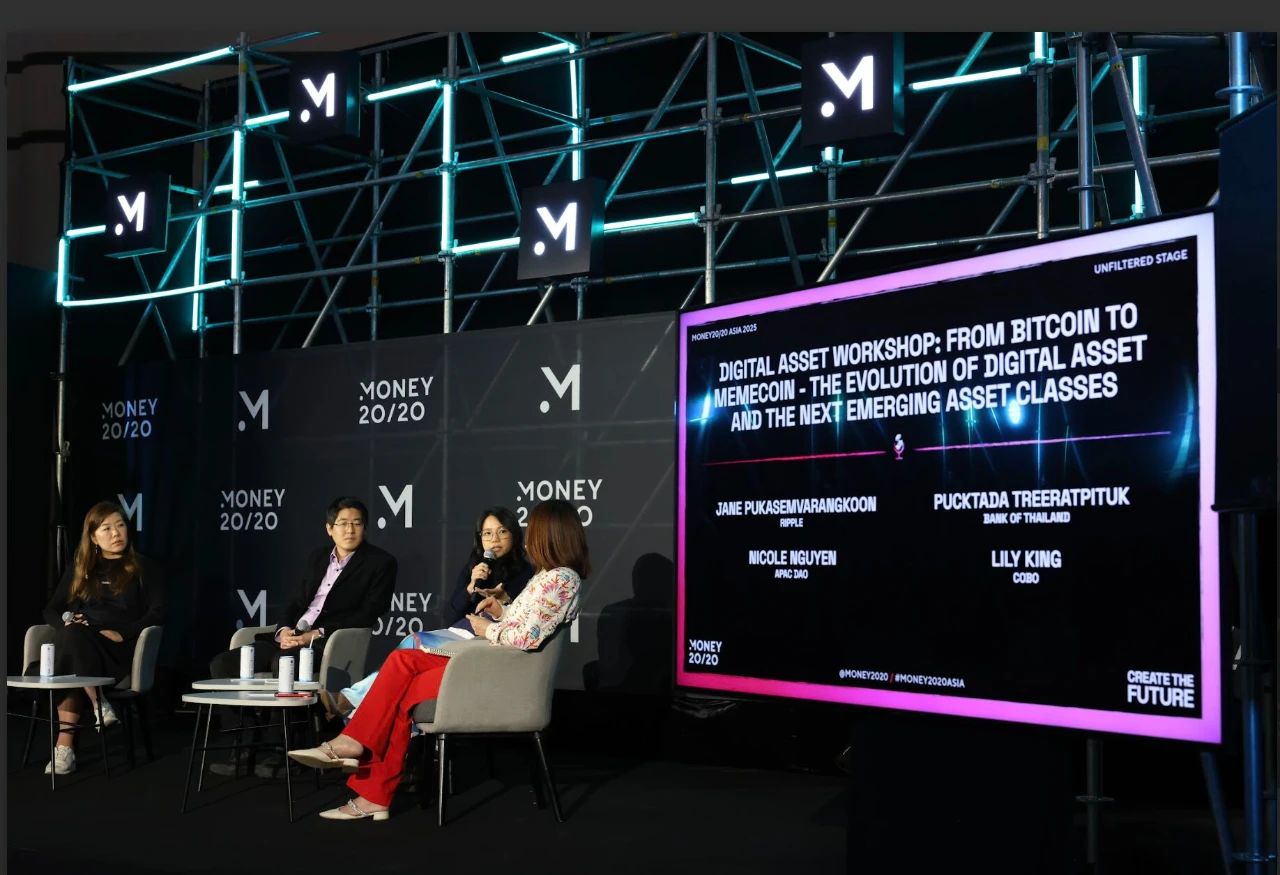"The future of digital assets is a co-creation and win-win situation for the entire ecosystem." This is not only a trend but also an inevitability in the development of the industry.
Written by: Lily Z. King
In April, the globally renowned fintech event Money20/20 Asia 2025 was held in Bangkok. Cobo COO Lily Z. King was invited to participate in a roundtable discussion hosted by APAC DAO founder Nicole Nguyen, alongside guests such as Pucktada Treeratpituk, head of payment systems and fintech at the Bank of Thailand, and Jane Pukasemvarangkoon, strategic client director for Ripple in the Asia-Pacific region, to explore the trends, opportunities, and challenges in the development of digital assets.
We have compiled Lily's core viewpoints from this discussion to share with Cobo's users and readers.

From DeFi to RWA: Structural Upgrades of On-Chain Assets
In the past few years, the blockchain world has experienced the ICO boom and the prosperity of DeFi, driven primarily by the crypto-native community. However, as on-chain incentives gradually weaken and DeFi yields normalize, the appeal of purely on-chain assets has begun to decline. At this time, Real World Assets (RWA) have emerged, providing users with new investment opportunities.
RWA brings the stable returns of traditional financial markets on-chain, such as the 4-5% yield of U.S. Treasury bonds, while leveraging blockchain technology for instant settlement, global access, and complete transparency. BlackRock's BUIDL fund is one of the best examples, rapidly reaching $1.4 billion in just one year. This marks the beginning of institutional investors recognizing and actively participating in on-chain asset investments.
More importantly, the RWA wave is just beginning. In the future, artworks, intellectual property, farmland, green energy projects, startup equity, and even personal income rights will gradually be brought on-chain. This is not only an increase in asset classes but also a structural upgrade of on-chain assets.
At the same time, the blockchain-native community, representing pioneering innovation, will certainly rise again, although this resurgence may occur only in niche areas and among specific audiences rather than entering the mass market.
In the Context of Global Trade Uncertainty, Stablecoins Become Mainstream Payment Solutions
Currently, the global trade situation is complex, with escalating trade frictions and significantly increased friction costs for cross-border capital flows. In this context, stablecoins and naturally borderless assets like Bitcoin are beginning to play a more important role.
These assets, due to their characteristics of instant settlement, borderless restrictions, and 24/7 operation, are gradually becoming the mainstream channel for global capital flow. They are unaffected by geopolitical influences, providing a truly neutral payment channel that effectively helps institutions and individuals reduce the risks and costs associated with global trade uncertainty.
The Essence of Web3 Development: The Integration of Technological Innovation and Meme Culture Communities
Web3 is not just a technological innovation; it is also a profound social and cultural phenomenon. The rise of meme coins is a vivid manifestation of this trend. Rather than viewing meme coins simply as speculative products, they should be seen as the "first lesson" for the younger generation of users entering the blockchain world. Meme coins, as carriers of trendy culture, help new users quickly familiarize themselves with decentralized exchanges (DEX), liquidity pools, and self-custody wallets.
This combination of culture and technology not only promotes the popularization of digital assets but also introduces a large number of new-generation users to the industry, laying a solid foundation for the sustained development of digital assets.
The Biggest Challenge to the Popularization of Digital Assets: Wallet Security and Usability
In the traditional financial system, bank accounts serve merely as endpoints for asset storage and transfer, while in the Web3 world, wallets are the core entry point for users to engage in all on-chain activities. This endows wallets with significant functionality but also brings complexity and security risks in usage.
To truly achieve widespread adoption of digital assets, wallet infrastructure must continuously iterate and optimize. Current industry innovations such as MPC wallets, account abstraction, smart contract wallets, and zero-knowledge proofs are effectively lowering the barriers for user entry. This is precisely the direction that Cobo's product portfolio is promoting.
Additionally, the integration of AI Agent technology will significantly enhance wallet security, building a more robust asset protection system.
Diverse Co-Creation and Ecological Win-Win: The Future Path of Digital Assets
The future of digital assets will not be dominated by a single asset, a single market, or a single type of participant, but will require the joint participation of the entire ecosystem. We need stable assets like Bitcoin that possess reserve attributes, as well as meme coins that have creative and cultural attributes.
Moreover, structured regulation in mature markets and the large-scale entry of institutional investors can bring stable funding and professional management, while emerging markets and individual users contribute innovative vitality and diverse demands to the ecosystem.
"The future of digital assets is a co-creation and win-win situation for the entire ecosystem." This is not only a trend but also an inevitability in the development of the industry.
免责声明:本文章仅代表作者个人观点,不代表本平台的立场和观点。本文章仅供信息分享,不构成对任何人的任何投资建议。用户与作者之间的任何争议,与本平台无关。如网页中刊载的文章或图片涉及侵权,请提供相关的权利证明和身份证明发送邮件到support@aicoin.com,本平台相关工作人员将会进行核查。




